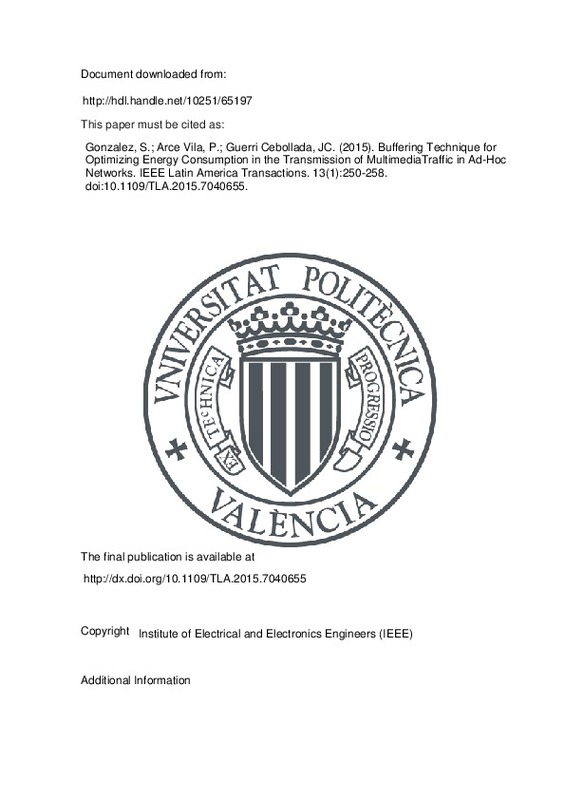JavaScript is disabled for your browser. Some features of this site may not work without it.
Buscar en RiuNet
Listar
Mi cuenta
Estadísticas
Ayuda RiuNet
Admin. UPV
Buffering Technique for Optimizing Energy Consumption in the Transmission of MultimediaTraffic in Ad-Hoc Networks
Mostrar el registro sencillo del ítem
Ficheros en el ítem
| dc.contributor.author | Gonzalez, S.
|
es_ES |
| dc.contributor.author | Arce Vila, Pau
|
es_ES |
| dc.contributor.author | Guerri Cebollada, Juan Carlos
|
es_ES |
| dc.date.accessioned | 2016-06-03T10:43:28Z | |
| dc.date.available | 2016-06-03T10:43:28Z | |
| dc.date.issued | 2015-01 | |
| dc.identifier.issn | 1548-0992 | |
| dc.identifier.uri | http://hdl.handle.net/10251/65197 | |
| dc.description.abstract | Energy constraints on wireless nodes represent a current field of research. Such restrictions are particularly significant because of the great amount of features and applications currently available on devices, which contribute to dramatically increase energy consumption. However, when transmitting delay-sensitive data, such as multimedia streaming, a balance between energy optimization and quality of service is required. In this sense, there are many works that address this issue from different layers of network architecture separately; however, a more efficient solution could be achieved by combining the management capabilities of the different layers and the joint use of such information, which is called a crosslayer mechanism. Moreover, despite the fact that the IEEE 802.11 standard defines an energy management mechanism at MAC level, it is envisaged only for structured networks, leaving just general guidelines for other kind of networks, such as Ad- Hoc networks. Therefore, as a first step towards the design of a cross-layer scheme, this paper analyzes the flaws of IEEE 802.11 standard as regards the infrastructureless mode and proposes an optimization mechanism for energy management in Ad-Hoc networks. The proposed approach is based on a buffering mechanism, which is able to increase power-saving periods of time in Ad-Hoc nodes. Simulations using NS3 indicate that it is possible to obtain higher levels of residual energy at the end of a transmission using the proposed scheme. | es_ES |
| dc.language | Inglés | es_ES |
| dc.publisher | Institute of Electrical and Electronics Engineers (IEEE) | es_ES |
| dc.relation.ispartof | IEEE Latin America Transactions | es_ES |
| dc.rights | Reserva de todos los derechos | es_ES |
| dc.subject | Energy Aware QoS | es_ES |
| dc.subject | Energy Efficiency | es_ES |
| dc.subject | Multimedia | es_ES |
| dc.subject | Ad-Hoc Networks | es_ES |
| dc.subject.classification | INGENIERIA TELEMATICA | es_ES |
| dc.title | Buffering Technique for Optimizing Energy Consumption in the Transmission of MultimediaTraffic in Ad-Hoc Networks | es_ES |
| dc.type | Artículo | es_ES |
| dc.identifier.doi | 10.1109/TLA.2015.7040655 | |
| dc.rights.accessRights | Abierto | es_ES |
| dc.contributor.affiliation | Universitat Politècnica de València. Departamento de Comunicaciones - Departament de Comunicacions | es_ES |
| dc.contributor.affiliation | Universitat Politècnica de València. Instituto Universitario de Telecomunicación y Aplicaciones Multimedia - Institut Universitari de Telecomunicacions i Aplicacions Multimèdia | es_ES |
| dc.description.bibliographicCitation | Gonzalez, S.; Arce Vila, P.; Guerri Cebollada, JC. (2015). Buffering Technique for Optimizing Energy Consumption in the Transmission of MultimediaTraffic in Ad-Hoc Networks. IEEE Latin America Transactions. 13(1):250-258. doi:10.1109/TLA.2015.7040655 | es_ES |
| dc.description.accrualMethod | S | es_ES |
| dc.relation.publisherversion | http://dx.doi.org/10.1109/TLA.2015.7040655 | es_ES |
| dc.description.upvformatpinicio | 250 | es_ES |
| dc.description.upvformatpfin | 258 | es_ES |
| dc.type.version | info:eu-repo/semantics/publishedVersion | es_ES |
| dc.description.volume | 13 | es_ES |
| dc.description.issue | 1 | es_ES |
| dc.relation.senia | 285996 | es_ES |







![[Cerrado]](/themes/UPV/images/candado.png)

